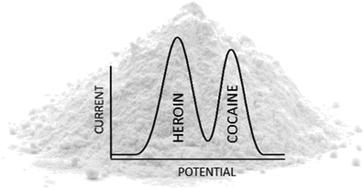Our official English website, www.x-mol.net, welcomes your
feedback! (Note: you will need to create a separate account there.)
Electrochemical analysis of speedball-like polydrug samples.
Analyst ( IF 3.6 ) Pub Date : 2020-07-28 , DOI: 10.1039/d0an01097a Mats de Jong 1 , Anca Florea , Devin Daems , Joren Van Loon , Nele Samyn , Karolien De Wael
Analyst ( IF 3.6 ) Pub Date : 2020-07-28 , DOI: 10.1039/d0an01097a Mats de Jong 1 , Anca Florea , Devin Daems , Joren Van Loon , Nele Samyn , Karolien De Wael
Affiliation

|
Increasing global production, trafficking and consumption of drugs of abuse is an emerging threat to people's health and safety. Electrochemical approaches have been proved to be useful for on-site analysis of drugs of abuse. However, less attention has been focused on the analysis of polydrug samples, even though these samples pose severe health concerns, especially when stimulants and depressants are combined, as is the case of speedball, a mixture of cocaine and heroin. In this work, we provide solutions for the selective detection of cocaine (stimulant) in polydrug samples adulterated with heroin and codeine (depressants). The presence of either one of these compounds in cocaine street samples leads to an overlap with the cocaine signal in square-wave voltammetry measurements at unmodified carbon screen-printed electrodes, leading to inconclusive screening results in the field. The provided solutions to this problem consist of two parallel approaches: (i) cathodic pretreatment of the carbon screen-printed electrode surface prior to measurement under both alkaline and neutral conditions and (ii) electropolymerization of orthophenylenediamine on graphene modified carbon screen-printed electrodes prior to measurement under neutral conditions. Both strategies allow simultaneous detection of cocaine and heroin in speedball samples as well as simultaneous detection of cocaine and codeine. Implementing these strategies in portable devices holds great potential for significantly improved accuracy of on-site cocaine screening in polydrug samples.
中文翻译:

速球状多药样品的电化学分析。
全球滥用毒品的生产,贩运和消费的增加对人们的健康和安全构成了新的威胁。电化学方法已被证明可用于滥用药物的现场分析。但是,尽管这些样品引起严重的健康问题,尤其是当兴奋剂和抑制剂合用时,如速球(可卡因和海洛因的混合物),对多药样品的分析却很少关注。在这项工作中,我们提供了在掺有海洛因和可待因(抑制剂)的多药样品中选择性检测可卡因(兴奋剂)的解决方案。在未经修饰的碳丝网印刷电极上,可卡因街头样品中这些化合物之一的存在会导致与可卡因信号在方波伏安法测量中发生重叠,导致该领域不确定的筛查结果。针对此问题提供的解决方案包括两种并行方法:(i)在碱性和中性条件下进行测量之前,对碳丝网印刷电极表面进行阴极预处理,以及(ii)之前在石墨烯改性的碳丝网印刷电极上邻苯二胺的电聚合在中性条件下进行测量。两种策略都允许同时检测速球样品中的可卡因和海洛因,以及同时检测可卡因和可待因。在便携式设备中实施这些策略具有极大的潜力,可以显着提高多元药物样品中现场可卡因筛查的准确性。(i)在碱性和中性条件下进行测量之前,对碳丝网印刷电极表面进行阴极预处理,以及(ii)在中性条件下进行测量之前,邻苯二胺在石墨烯改性的碳丝网印刷电极上进行电聚合。两种策略都允许同时检测速球样品中的可卡因和海洛因,以及同时检测可卡因和可待因。在便携式设备中实施这些策略具有极大的潜力,可以显着提高多元药物样品中现场可卡因筛查的准确性。(i)在碱性和中性条件下进行测量之前,对碳丝网印刷电极表面进行阴极预处理,以及(ii)在中性条件下进行测量之前,将邻苯二胺在石墨烯改性的碳丝网印刷电极上进行电聚合。两种策略都允许同时检测速球样品中的可卡因和海洛因,以及同时检测可卡因和可待因。在便携式设备中实施这些策略具有极大的潜力,可以显着提高多元药物样品中现场可卡因筛查的准确性。
更新日期:2020-09-14
中文翻译:

速球状多药样品的电化学分析。
全球滥用毒品的生产,贩运和消费的增加对人们的健康和安全构成了新的威胁。电化学方法已被证明可用于滥用药物的现场分析。但是,尽管这些样品引起严重的健康问题,尤其是当兴奋剂和抑制剂合用时,如速球(可卡因和海洛因的混合物),对多药样品的分析却很少关注。在这项工作中,我们提供了在掺有海洛因和可待因(抑制剂)的多药样品中选择性检测可卡因(兴奋剂)的解决方案。在未经修饰的碳丝网印刷电极上,可卡因街头样品中这些化合物之一的存在会导致与可卡因信号在方波伏安法测量中发生重叠,导致该领域不确定的筛查结果。针对此问题提供的解决方案包括两种并行方法:(i)在碱性和中性条件下进行测量之前,对碳丝网印刷电极表面进行阴极预处理,以及(ii)之前在石墨烯改性的碳丝网印刷电极上邻苯二胺的电聚合在中性条件下进行测量。两种策略都允许同时检测速球样品中的可卡因和海洛因,以及同时检测可卡因和可待因。在便携式设备中实施这些策略具有极大的潜力,可以显着提高多元药物样品中现场可卡因筛查的准确性。(i)在碱性和中性条件下进行测量之前,对碳丝网印刷电极表面进行阴极预处理,以及(ii)在中性条件下进行测量之前,邻苯二胺在石墨烯改性的碳丝网印刷电极上进行电聚合。两种策略都允许同时检测速球样品中的可卡因和海洛因,以及同时检测可卡因和可待因。在便携式设备中实施这些策略具有极大的潜力,可以显着提高多元药物样品中现场可卡因筛查的准确性。(i)在碱性和中性条件下进行测量之前,对碳丝网印刷电极表面进行阴极预处理,以及(ii)在中性条件下进行测量之前,将邻苯二胺在石墨烯改性的碳丝网印刷电极上进行电聚合。两种策略都允许同时检测速球样品中的可卡因和海洛因,以及同时检测可卡因和可待因。在便携式设备中实施这些策略具有极大的潜力,可以显着提高多元药物样品中现场可卡因筛查的准确性。











































 京公网安备 11010802027423号
京公网安备 11010802027423号